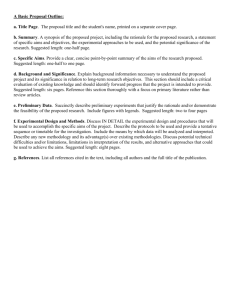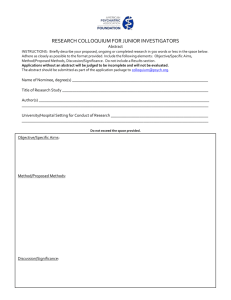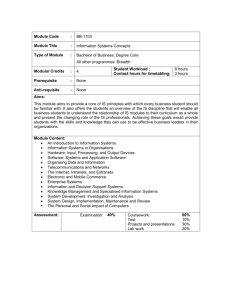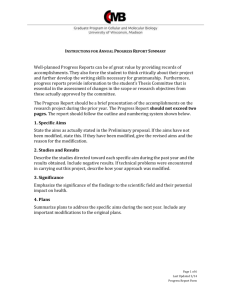1 The title should be clear and succinct, and address the... THESIS PROPOSAL GUIDELINES
advertisement
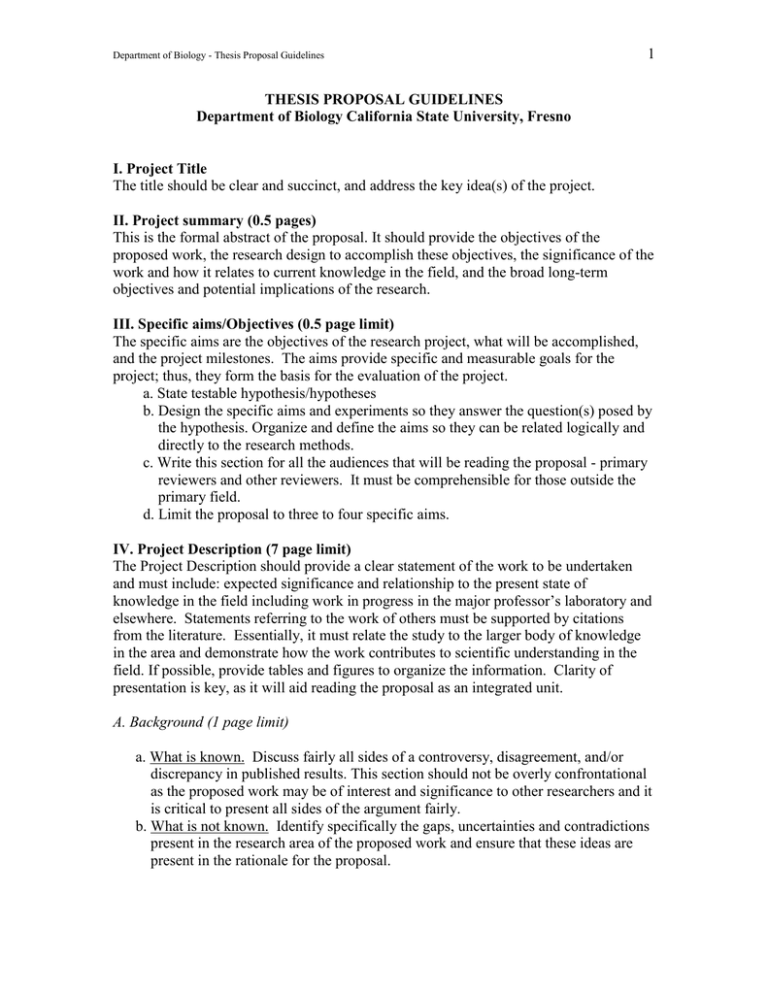
Department of Biology - Thesis Proposal Guidelines 1 THESIS PROPOSAL GUIDELINES Department of Biology California State University, Fresno I. Project Title The title should be clear and succinct, and address the key idea(s) of the project. II. Project summary (0.5 pages) This is the formal abstract of the proposal. It should provide the objectives of the proposed work, the research design to accomplish these objectives, the significance of the work and how it relates to current knowledge in the field, and the broad long-term objectives and potential implications of the research. III. Specific aims/Objectives (0.5 page limit) The specific aims are the objectives of the research project, what will be accomplished, and the project milestones. The aims provide specific and measurable goals for the project; thus, they form the basis for the evaluation of the project. a. State testable hypothesis/hypotheses b. Design the specific aims and experiments so they answer the question(s) posed by the hypothesis. Organize and define the aims so they can be related logically and directly to the research methods. c. Write this section for all the audiences that will be reading the proposal - primary reviewers and other reviewers. It must be comprehensible for those outside the primary field. d. Limit the proposal to three to four specific aims. IV. Project Description (7 page limit) The Project Description should provide a clear statement of the work to be undertaken and must include: expected significance and relationship to the present state of knowledge in the field including work in progress in the major professor’s laboratory and elsewhere. Statements referring to the work of others must be supported by citations from the literature. Essentially, it must relate the study to the larger body of knowledge in the area and demonstrate how the work contributes to scientific understanding in the field. If possible, provide tables and figures to organize the information. Clarity of presentation is key, as it will aid reading the proposal as an integrated unit. A. Background (1 page limit) a. What is known. Discuss fairly all sides of a controversy, disagreement, and/or discrepancy in published results. This section should not be overly confrontational as the proposed work may be of interest and significance to other researchers and it is critical to present all sides of the argument fairly. b. What is not known. Identify specifically the gaps, uncertainties and contradictions present in the research area of the proposed work and ensure that these ideas are present in the rationale for the proposal. Department of Biology - Thesis Proposal Guidelines 2 c. Why is it essential to find out what is not known. Identify how the proposed work will extend the knowledge base of the field and any specifics that makes the proposed work unique. B. Rationale & Significance (1 page limit) a. State the importance of the research described in this application relating it to the specific aims and long-term objectives. b. List the possible outcomes of the research and how will it improve understanding of the problem. c. Justify the model organism: Why is it appropriate for this research. C. Preliminary Data (1 page limit) (This section is optional) Some students initiate their research activity almost immediately or have data sets originating from previous activities. In these cases, data relevant to the proposed work should be presented in a manner to justify the proposal and support the hypotheses. D. Experimental Design (3 page limit) The Specific Aims section states the proposed work, the Background section identifies the rationale behind each aim. This section identifies the methodology for how each aim will be fulfilled. There should be a very clear link between the methods described in this section and the aims identified in section III. If the experimental design or methodology is inappropriate for the hypotheses proposed, there will be a limited ability to draw firm conclusions. The writing in this section must be clear and state exactly how the chosen methods will fulfill the project's objectives and address the research problem on which the proposal is focused. a. Be focused and clear. Break this section into each Specific Aim and outline the design and methods to accomplish that Specific Aim. Also explain why the proposed approach was chosen. b. Number the research designs and methods to correspond to the numbers of the Specific Aims. c. Distinguish clearly between overall research design and specific methods. d. Do not repeat identical procedures that apply to more than one Specific Aim. e. Reference, but do not describe well-known or standard procedures. Do describe procedures that are new or unlikely to be known to reviewers. For new methods, briefly explain why they are better than existing methods. f. Discuss relevant control experiments. g. Explain the processes for data collection, analysis and interpretation. The experiment(s) proposed must be designed in such a way that appropriate statistical analyses will be possible. i. Identify expected outcomes, pitfalls and limitations associates with the proposed work. Discuss what the expected outcomes are of the proposed work and identify defined criteria for evaluating the success or failure of each experiment. Discuss potential difficulties and limitations of the proposed procedures and give alternative procedures to achieve the aims. Department of Biology - Thesis Proposal Guidelines 3 IV. Timeline Provide a brief tentative sequence and timetable for the project. List them in order. Consider doing this using a diagram or table. Clearly define the priorities of the research. V. References (no page limit) Cite and reference the results and discussion of a journal article and not the introduction. The cited references should be arranged alphabetically, citation possessing the same author should have the older citation presented first. Literature citations in the body of the proposal should be in parentheses and contain only the author's last name and the date; for multiple authors include the last name of the first author, et al., and the date. If the author's name is used in the text then just the date in parentheses is sufficient. For example: (Monod, 1949) or (Neidhardt et al., 1990) or “Monod (1949) compared the reaction rates between….” Remember that the proposed work is to be referenced in the context of, and contribute to, the existing body of scientific work in that area. VI. Budget The budget should be an approximate and realistic estimate of the resources required to accomplish the proposed work and reflect the goals of the project. It must also be consistent with the availability of resources in the laboratory in which the work is being performed.
